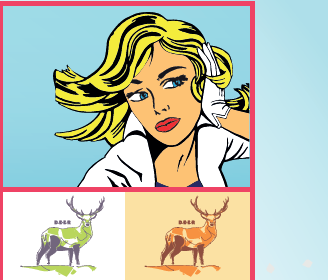POP ART
Pop Art is a visual arts movement of the 50s and 60s in the USA and Britain. It was born in New York and London, the new art centres of the western world. Pop Art was the art of popular culture. The images of Pop Art (a short form for Popular Art) came from mass culture and ordinary objects from everyday life. Artists duplicated drink bottles, soup cans, comic strips and road signs in paintings, collages and sculptures, showing the materialism of modern mass culture. The objects are enlarged, simplified and coloured differently. Pop Art influenced many artists and also adopted techniques of mass production, so artists didn’t make one original but produced series of the same objects. Pop Art was brash, young and fun and hostile to the artistic establishment. Pop Art reflected upon contemporary reality and the cultural changes of the 1960's: the music of the Beatles and the Rolling Stones, the idealism of the Kennedy era, the reality of the assassination of President John F. Kennedy in 1963, the outbreak of the Vietnam war in 1964, and other social events. Andy Warhol (1928-1987) was the principal figure in the Pop Art movement: he was an American painter, filmmaker, publisher and actor and made identical prints of familiar objects, like Coca-Cola bottles and Campbell’s soup cans. In his works he used repetition and unnatural colours and often portrayed famous personalities from popular culture, from Liz Taylor to Elvis Presley. Warhol's quote, "In the future everybody will be famous for fifteen minutes", is known all over the world.
Adapted from The Good World Guide, EuroPass ed., 2003

